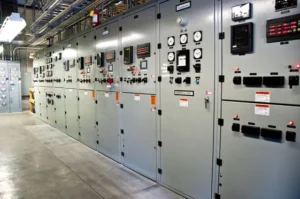Understanding LT Panels in MEP Construction : A Complete Overview

In MEP construction, LT panels in MEP Construction Services are vital to guarantee the effective flow of electrical power in residential, commercial, and industrial configurations. For MEP service professionals, knowledge of LT panel design, operation, and implementation within mechanical, electrical, and plumbing (MEP) systems is vital to ensure smooth operations.
What is an LT Panel?
An LT Panels in MEP Construction Services is an electrical panel made to control and distribute low voltage (less than 1000V) electricity. They are the backbone of electric distribution within buildings and a key element in MEP civil engineering work. They control, protect, and regulate electrical equipment, providing safety and efficiency.
Major Components of LT Panels
Circuit Breakers – Safe guard electrical circuits from overloading and short circuits.
Busbars – Supply power to several outgoing circuits.
Relays – Assist in automatic control and protection of the system.
Meters – Measure voltage, current, and power consumption.
Fuses – Add an extra layer of protection against overcurrent.
These elements play a significant role in MEP in engineering, where electrical systems have to function with mechanical as well as plumbing installations.
Importance of LT Panels in MEP Construction
In MEP construction, electrical, mechanical, and plumbing systems need to be synchronized for efficient operation of a building. LT panels are key to this synchronization because:
They allow all electric equipment to be controlled centrally.
Improve safety and reliability by eliminating electrical risks.
Enable effective energy management, which is essential in today’s MEP projects.
Enable smooth integration with MEP civil engineering systems such as HVAC, fire alarms, and lighting.
Types of LT Panels in MEP Services
LT panels are engineered according to the intended application. Most widely used are:
Distribution Panels – To distribute electricity to several circuits.
Motor Control Panels – Specifically tailored for motor control in HVAC and other machinery systems.
Automatic Transfer Panels (ATS) – Switch power automatically between main supply and backup generators.
Capacitor Panels – Enhance power factor in industrial installations.
Every type of LT panel plays an important role in MEP services to make the electrical system of the building function optimally in cooperation with mechanical and plumbing systems.
LT Panels and Mechanical, Electrical & Plumbing (MEP) Integration
In contemporary construction, MEP in engineering requires that all the systems complement each other. For example:
Electrical systems controlled by LT panels provide power to mechanical systems such as HVAC units.
LT panels keep plumbing systems that are dependent on electric pumps or sensors running uninterruptedly.
Effective integration keeps downtimes and maintenance to a minimum, an important objective in MEP civil engineering projects.
Installation and Maintenance Considerations
LT panel installation calls for prior planning in MEP construction projects
Leave enough space for ventilation and growth in the future.
Coordinate cable routes with minimal interference with mechanical and plumbing systems.
Maintenance checks at regular intervals are crucial to avoiding faults and extending the life of the panels.
For MEP services providers, following these considerations provides safety, efficiency, and electrical standard compliance.
Conclusion
Overall, LT panels are an integral part in MEP construction and MEP civil engineering. They are a source of centralized control, safety, and fluent integration for mechanical, electrical, and plumbing (MEP) systems. Know-how of their types, components, and installation best practices is vital for engineers and contractors to provide efficient, reliable, and safe buildings.
Incorporating LT panels successfully into MEP services guarantees not only efficient operation but also sustainability and energy efficiency in the long run, rendering them vital to contemporary engineering projects.
Quote:
LT Panels play a critical role in MEP construction, facilitating effective and secure transmission of electricity in home, office, and industrial buildings. Blending in with mechanical, electrical, and plumbing (MEP) systems, these panels are helping power management, dependability, and efficiency of operation. Awareness of their types, parts, and function in MEP civil engineering is fundamental to contemporary building constructions.


